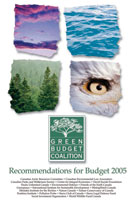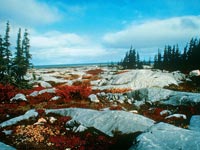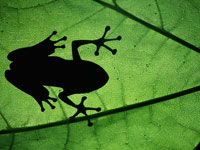
News |
- Keep Environmental Promises, Use Green Budget
- Mackenzie Pipeline Panel Halts Review
- Federal Anti-Pollution Gaps Revealed
- Company Pulls Out of Arctic Oil Lobby
- European Birds in Trouble
- Amphibians in Dramatic Decline
- Poverty, Disease, Environmental Decline 'Axis of Evil'
- North American Disruption of Wildlife Populations Forecast
- Conserve Canada's Boreal Region - CBI
- Political Temperature Rises as Kyoto Date Nears
- UN Report Seeks Safe Drinking Water
- Ad Exposes Victoria Secret Forest Destruction
| Keep Environmental Promises, Use Green Budget | 10 February 05 |
 Twenty-one of Canada's leading environmental and conservation groups released a report on February 8, 2005 calling on federal political parties to set aside their differences and to move forward quickly with a green budget. Twenty-one of Canada's leading environmental and conservation groups released a report on February 8, 2005 calling on federal political parties to set aside their differences and to move forward quickly with a green budget.The report, Green Budget Coalition: Recommendations for Budget 2005 shows the parties how they can use the upcoming budget to keep the environmental promises they've made to Canadians. "The federal budget is the single most important annual environmental policy statement made by the government," said Julie Gelfand, President of Nature Canada. "If the parties are serious about responsible government spending, they should start with the millions of dollars in handouts that subsidize polluters." "Manitoba's upcoming budget must contain similar initiatives. We would also expect our government to fill the many vacant science staff positions and enable East Side land use planning," said Gaile Whelan Enns, Director, Manitoba Wildlands. The Green Budget Coalition's report details how the budget can be used to put greener cars on the roads, provide greater protection for Canada's over-stressed coastal regions, and enable Canada to meet its Kyoto target. View the February 8, 2005 Green Budget Coalition press release View the Green Budget Coalition: Recommendations for Budget 2005 report Source: Green Budget Coalition |
|
| Mackenzie Pipeline Panel Halts Review | 10 February 05 |
 The environmental review of the proposed Mackenzie Valley natural gas pipeline has been halted until Imperial Oil Ltd. and other backers spell out how the $7-billion mega project will affect communities along its 1,220-kilometre route. The environmental review of the proposed Mackenzie Valley natural gas pipeline has been halted until Imperial Oil Ltd. and other backers spell out how the $7-billion mega project will affect communities along its 1,220-kilometre route.In a four-page letter addressed to the Manager of Regulatory Affairs for the Mackenzie Gas Project, the chairman of the panel, Robert Hornel, spells out several shortcomings in Imperial Oil's 6,500-page submission. Imperial Oil heads the five-member consortium proposing the pipeline, designed to carry natural gas from the Arctic coast to northern Alberta by the end of the decade. Mr. Hornel concludes the letter by cautioning the consortium that until it provides the needed information, the panel will not schedule hearings. It is the third time the panel has asked for more specifics. Imperial Oil said it is aiming to assemble its response as quickly as possible, noting it has received more than 600 other requests for information from third parties. The joint panel combines the efforts of three agencies that would have otherwise conducted separate reviews. A spokeswoman for the panel said it does not have the power to approve or halt the Mackenzie pipeline. However, its environmental assessment report will be used by the National Energy Board, which does have such authority. View the February 5, 2005 Globe and Mail Article (DOC) View the February 3, 2005 letter from the Joint Review Panel to the proponents of the Mackenzie Gas Project (PDF) Visit the Joint Review Panel for the Mackenzie Gas Project web site Visit the Northern Gas Project Secretariat web site View the Summary of Submissions to Information Request (IR) Round 1 by Organization regarding the Mackenzie Gas Project (PDF) View the January 18, 2005 Manitoba Wildlands news item regarding the Mackenzie Gas Project Source: Globe and Mail |
|
| Federal Anti-Pollution Gaps Revealed | 08 February 05 |
 An internal federal document indicates the government badly under-funded a strategy adopted in 1999 to protect Canadians and the environment from dangerous toxins. An internal federal document indicates the government badly under-funded a strategy adopted in 1999 to protect Canadians and the environment from dangerous toxins. According to The Hill Times, the document was obtained under the Access to Information Act by "Toronto-based Environmental Defence, which, like many environmental groups, is gearing up for a major fight as Canada's most important anti-pollution law, the 1999 Canadian Environmental Protection Act (CEPA), comes up for its five-year review this spring in Parliament." The document identifies a funding gap of $23.3 million between 2000 and 2003. Among other provisions CEPA requires the assessment and categorization of the 23,000 agents on the Domestic Substances List by September 2006. According to the document, at the present rate this will take 25 years. "It's five years later, not one single chemical has been listed for elimination under CEPA," said Rick Smith of Environmental Defence. Mark Winfield of the Pembina Institute suspects there are "hundreds" of dangerous substances on the Domestic Substances List. View The Hill Times' article View the report Shattering the Myth of Pollution Progress in Canada Source: The Hill Times |
|
| Company Pulls Out of Arctic Oil Lobby | 08 February 05 |
 ConocoPhillips has dropped out of Arctic Power, a high-profile group that lobbies for opening up the Arctic National Wildlife Refuge in Alaska to oil and gas drilling. ConocoPhillips has dropped out of Arctic Power, a high-profile group that lobbies for opening up the Arctic National Wildlife Refuge in Alaska to oil and gas drilling.The company's departure from Arctic Power follows another major oil company, BP Plc's withdrawal from the group in November 2002. The move also comes as the US Congress gears up to reopen the debate on drilling in the oil-rich Arctic National Wildlife Refuge, currently closed to production. President Bush supports opening the area to exploration and analysts have speculated that his victory in November's presidential election would give a boost to oil companies' efforts there. Moderate Republicans and Democrats in the US Senate oppose the drilling plan. Environmentalists, who have buffeted oil companies with e-mail and shareholder resolutions over the issue, hailed ConocoPhillips' decision as a victory for the movement to keep the region closed to oil exploration. View the January 6, 2005 Planet Ark article from Reuters View previous 2004 coverage by Manitoba Wildlands Source: Reuters |
|
| European Birds in Trouble | 08 February 05 |
 Almost half of the species of birds in Europe are at risk of disappearing, according to a report by BirdLife International. In the ten years since the publication of BirdLife's original European study, 45 bird species have declined in numbers and now have an unfavourable conservation status. Almost half of the species of birds in Europe are at risk of disappearing, according to a report by BirdLife International. In the ten years since the publication of BirdLife's original European study, 45 bird species have declined in numbers and now have an unfavourable conservation status.The latest assessment, published in BirdLife's in-depth study, Birds in Europe, reveals that 226 species of birds - 43 per cent of all those occurring regularly in Europe - are facing an uncertain future. Some are now so threatened that they may disappear from parts of Europe in the very near future. On the positive side, 14 bird species have seen their fortunes improve; thanks, in part, to concentrated conservation efforts. View the BirdLife International news release View the CBC news story Sources: BirdLife International, CBC News |
|
| Amphibians in Dramatic Decline | 03 February 05 |
 The world's first census of amphibians found that nearly one in three species is under threat of extinction. The Global Amphibian Assessment (GAA) is the first-ever comprehensive assessment of the conservation status of the world's 5,743 known species of frogs, toads, salamanders, and caecilians. The world's first census of amphibians found that nearly one in three species is under threat of extinction. The Global Amphibian Assessment (GAA) is the first-ever comprehensive assessment of the conservation status of the world's 5,743 known species of frogs, toads, salamanders, and caecilians.Over the past three years, scientists analyzed the distribution and conservation status of all 5,743 known amphibian species. Of these, 1,856 - or 32 percent - are now considered threatened with extinction. Sufficient data are lacking to accurately assess the status of nearly 1,300 other species, most of which scientists believe are also threatened. The findings are dramatic proof that the rate of global extinctions is proceeding thousands of times faster than expected. The study is also particularly significant because amphibians are widely regarded as "canaries in the coal mine," since their highly permeable skin is more immediately sensitive to changes in the environment, including changes to freshwater and air quality. The Global Amphibian Assessment is a collaborative effort of scientists from IUCN (The World Conservation Union), Conservation International, and NatureServe, with participation by over 500 amphibian experts from more than 60 countries. View the Global Amphibian Assessment press release (PDF) Visit the Global Amphibian Assessment website View Globe and Mail coverage of the Global Amphibian Assessment Sources: Global Amphibian Assessment, IUCN, Globe and Mail |
|
| Poverty, Disease, Environmental Decline 'Axis of Evil' | 03 February 05 |
 The global war on terror is diverting the world's attention from the central causes of instability, reports the Worldwatch Institute in its annual State of the World 2005. The global war on terror is diverting the world's attention from the central causes of instability, reports the Worldwatch Institute in its annual State of the World 2005.According to the report, acts of terror and the dangerous reactions they provoke are symptomatic of underlying sources of global insecurity, including the perilous interplay among poverty, infectious disease, environmental degradation, and rising competition over oil and other resources. In the State of the World 2005 foreword, former Soviet Union President and Green Cross International chairman Mikhail Gorbachev calls for a "Global Glasnost - openness, transparency, and public dialogue" and "a policy of 'preventive engagement' to meet the challenges of poverty, disease, environmental degradation, and conflict in a sustainable and nonviolent way." View the Worldwatch January 12, 2005 press release View a summary of the Worldwatch report State of the World 2005 Source: Worldwatch |
|
| North American Disruption of Wildlife Populations Forecast | 01 February 05 |
 A US-based group of wildlife professionals released the first comprehensive assessment of likely consequences of global warming for North American wildlife. The Wildlife Society report, Global Climate Change and Wildlife in North America, warns of possible major shifts in the ranges and the restructuring of entire plant and animal communities. A US-based group of wildlife professionals released the first comprehensive assessment of likely consequences of global warming for North American wildlife. The Wildlife Society report, Global Climate Change and Wildlife in North America, warns of possible major shifts in the ranges and the restructuring of entire plant and animal communities.The report finds "there is sufficient evidence to indicate that many species are already responding to warming, and animals and plants are already exhibiting discernible range changes consistent with changing temperatures." The disruption of essential ecological processes, displacement or disappearance of coastal wetlands, significant loss of coastal marshes and disruption of alpine and Arctic ecosystems are also detailed in the report. Direct threats to many species are reported, including polar bears, migratory songbirds and waterfowl and alpine amphibians. Founded in 1937, The Wildlife Society is the United States' preeminent association of wildlife professionals, including wildlife biologists and research scientists, habitat managers, field technicians, and educators. View the National Wildlife Federation December 15, 2004 press release View the full report Global Climate Change and Wildlife in North America (PDF) View a synopsis of the report Global Climate Change and Wildlife in North America (PDF) Visit the National Wildlife Federation web site Source: National Wildlife Federation |
|
| Conserve Canada's Boreal Region - CBI | 01 February 05 |
 The vast and intact state of Canada's Boreal region makes it the world's greatest conservation opportunity says a new report released January 31, 2005 by the Canadian Boreal Initiative (CBI). According to The Boreal in the Balance: Securing the Future of Canada's Boreal Region, this important region faces an uncertain future because expanding industrial development proposals are outpacing conservation efforts. The vast and intact state of Canada's Boreal region makes it the world's greatest conservation opportunity says a new report released January 31, 2005 by the Canadian Boreal Initiative (CBI). According to The Boreal in the Balance: Securing the Future of Canada's Boreal Region, this important region faces an uncertain future because expanding industrial development proposals are outpacing conservation efforts. The CBI report is the first-ever national report to examine the status of boreal conservation activities related to protected areas, land use planning, Aboriginal rights, sustainable development, and research. "Canada can be a world conservation leader - but our opportunity is time-limited," said CBI Director Cathy Wilkinson. "There is an urgent need to plan first, before development decisions are made," she said. "We can both protect the ecological and cultural values of this world treasure, and accommodate world-class sustainable development." The study highlights the East Side of Lake Winnipeg, the Mackenzie Valley, northern Saskatchewan, the East Side of Lake Winnipeg, and Labrador as areas of greatest potential for conservation-based planning in advance of new industrial developments, and points to the key role of Aboriginal people in developing innovative conservation models across the country. View Poplar River First Nation, and other CBI partner statements View the executive summary of the report The Boreal in the Balance: Securing the Future of Canada's Boreal Region (PDF) View the full report The Boreal in the Balance: Securing the Future of Canada's Boreal Region (PDF) Source: Canadian Boreal Initiative |
|
| Political Temperature Rises as Kyoto Date Nears | 01 February 05 |
 With concerns looming that Canada may give in to industry pressure and relax its commitment to Kyoto targets leading environmental groups are urging the Prime Minister to put forward a credible Kyoto implementation plan before February 16 when the Protocol comes into force. With concerns looming that Canada may give in to industry pressure and relax its commitment to Kyoto targets leading environmental groups are urging the Prime Minister to put forward a credible Kyoto implementation plan before February 16 when the Protocol comes into force.In a January 12 letter, signed by the Sierra Club of Canada, the David Suzuki Foundation, the Pembina Institute and others, the groups point to a discrepancy between stated government intentions to give Kyoto high priority and evidence that Canada may not intend to comply with its Kyoto commitments. The letter urges strong mandatory regulations that won't let industry off the hook. A Canadian Press report says the government is considering reducing required industry emission reductions from 73 megatonnes a year to just eight. At the same time federal Environment Minister Stéphane Dion threatened to impose vehicle emission restrictions on Canadian automakers if the industry does not agree to voluntary steps by February 16. The government says it wants to see a 25% improvement in vehicle efficiency by 2010. A recent poll commissioned by the David Suzuki Foundation shows almost 90% of Canadians want to see strict fuel efficiency standards for new vehicles. The Globe & Mail reports the government is "working furiously to unveil a new plan [before February 16] after discovering that four years of [emission reduction] efforts have yielded results far short of the target." View the letter from six environmental NGOs to the Prime Minister (PDF) View the Globe & Mail article about the environmentalists' letter to the Prime Minister View the poll commissioned by the David Suzuki Foundation View Sierra Club of Canada information on the proposal to reduce industry Kyoto targets View the Globe & Mail article about vehicle emissions View United Nations information on the Kyoto Protocol Sources: Sierra Club of Canada, David Suzuki Foundation, Globe & Mail |
|
| UN Report Seeks Safe Drinking Water | 27 January 05 |
 The recently released report of the UN Millennium Project Task Force on Water and Sanitation sets out a course for "reducing by half the proportion of the [global] population without safe drinking water and basic sanitation between the baseline year of 1990 and the target year of 2015" (Millennium Development Goal #10). The recently released report of the UN Millennium Project Task Force on Water and Sanitation sets out a course for "reducing by half the proportion of the [global] population without safe drinking water and basic sanitation between the baseline year of 1990 and the target year of 2015" (Millennium Development Goal #10).According to the report, "four out of every ten people in the world do not have access to even a simple pit latrine; and nearly two in ten have no source of safe drinking water." Though problems are concentrated in low-income countries, high-income nations have a reported 15 million people without access to improved water services. Water safety issues are common in Canada's aboriginal communities. According to a Health Canada document 65 First Nations and Inuit communities were under boil water advisories in 1999 (data does not include the territories). Advisories lasted for an average of six months. Indian and Northern Affairs Canada (INAC) representative Pierre Lamontagne told Manitoba Wildlands the situation is improving. In 2003/4, 25% of the water systems overseen by INAC were considered "high risk". That was down from 29% the previous year. He says we are going to see a "huge decrease" in that number over time. View the Stockholm International Water Institute release View the abridged UN Millennium water report (PDF) View the complete UN Millennium water report (PDF) View the Health Canada document regarding on-reserve water services (pp. 65-67) (PDF) View the Walkerton Report chapter on First Nations (PDF) Sources: UN Millennium Project Task Force on Water and Sanitation, Health Canada, INAC |
|
| Ad Exposes Victoria Secret Forest Destruction | 27 January 05 |
 An advertisement in the January 21, 2005 edition of The New York Times exposes Victoria's Secret and parent company Limited Brands for printing 395 million catalogs annually, predominately on paper made directly from forests. The company mails out more than one million catalogues daily. An advertisement in the January 21, 2005 edition of The New York Times exposes Victoria's Secret and parent company Limited Brands for printing 395 million catalogs annually, predominately on paper made directly from forests. The company mails out more than one million catalogues daily.Two years of investigative research revealed a direct link between Victoria's Secret catalogs and the destruction of old growth and Endangered Forests in the Canadian Boreal Forest. An international conservation spotlight is being focused on the Boreal; the destruction of this forest for the production of things like catalogs, junk mail and toilet paper has been featured on CNN. "The proof of Victoria's Secret's environmental 'commitment' is in its paper, the majority of which has no recycled content and is coming in large part from the world's last Endangered Forests, such as the Canadian Boreal," said Lafcadio Cortesi of ForestEthics. Each year, catalog retailers mail around 17 billion catalogs. That's 59 catalogs for every man, woman and child in the U.S. Yet almost none of this paper contains any recycled content. This means that every year, over eight million tons of trees go straight into catalogs that are often discarded unread. View the ForestEthics press release Visit the ForestEthics web site "Victoria's Dirty Secret" View the CNN story on the Boreal Forest View the Macleans story on Canadian Logging Source: ForestEthics |
|


 RSS Feeds:
RSS Feeds: